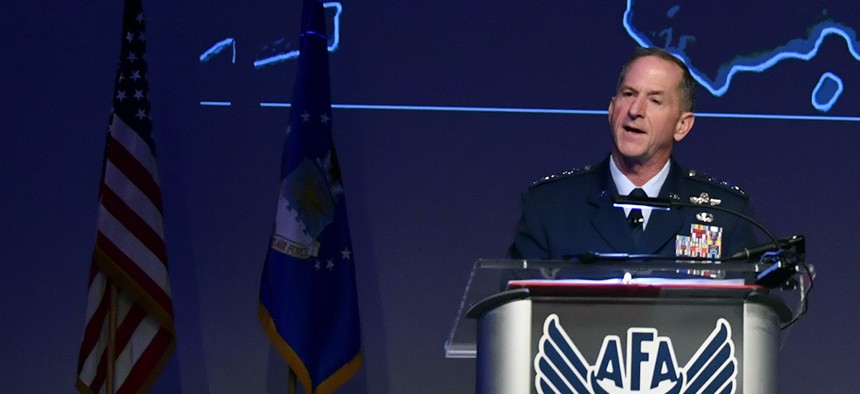
Gen. David Goldfein, the U.S. Air Force chief of staff, speaks at the Air Force Association's Air, Space, Cyber conference. Wayne Clark/USAF
US Air Force to Shift Billions of Dollars to Network Its Weapons
The clock is ticking on Gen. David Goldfein’s signature project.
Wait till next year! The Brooklyn Dodgers’ classic rallying cry might well belong to the U.S. Air Force these days.
Last year, service leaders showed up to the annual Air, Space & Cyber conference near Washington with a big message: they need 386 squadrons — one-quarter more than currently funded — to fight and win wars against China and Russia, as prescribed in the National Defense Strategy. Asked for details — How many planes? What kinds of planes? — the leaders responded: wait till next year.
Now it’s next year, and the Air Force Association’s giant conference is once again underway. So about those answers? Service officials say they’re coming — yes — next year, in the Pentagon’s 2021 budget proposal to Congress.
But for Gen. David Goldfein, there is no next year, at least not as the Air Force chief of staff. Now in the last of four as the top Air Force general, Goldfein is hustling to cement his legacy. Speaking at the conference, he promised “radical changes” in coming years.
Related: Extra-Long Sustainment Contracts Are Lockheed’s Latest Bid to Cut F-35 Costs
Related: Northrop Announces Suppliers For New ICBM. Boeing is Not on the List
Related: US Lawmaker Threatens to Give the Next Attack Plane to the Army
The Air Force is talking about creating a new battle network, fielding a new series of fighter jets every five years, and modifying existing weapons to make them more lethal and survivable. Goldfein also said the 2021 budget would contain “significant investment” in weapons that can strike heavily defended enemy targets.
Much of the money will be redirected from existing projects — echoing the Army’s year-old “night court” effort that is shifting $25 billion over five years into higher-priority programs. At the conference, Acting Air Force Secretary Matt Donovan said his service was planning to shift tens of billions of dollars as well — in the same “ballpark” as the Army.
The Air Force calls its “night court” a “zero-based review.” It was used for the 2019 and 2020 budgets and now again for the 2021 budget plan, which is typically sent to Congress in February.
“We wire-brushed every program in the United States Air Force and we graded that against the National Defense Strategy,” Goldfein said in a Tuesday speech. “As a result, you’re going to see some of the largest movement of resources” in the 2021 budget “in probably the last two to three decades.”
That money, Goldfein said, will build “the Air Force we need to do multi-domain operations.”
The general called the 2020 budget, which Congress still hasn’t approved, “the first budget which has complete National Defense Strategy alignment.”
Throughout his tenure as the Air Force’s 21st chief of staff, Goldfein’s top priority has remained the same: pushing his service to ensure that all of its weapons can connect with each other, and with those of the Army, Navy, Marine Corps and allies. He calls the concept multi-domain operations.
“This is going to be as hard for us culturally as it is technically to shift from a platform-centric orientation that we all grew up with to a network-centric orientation,” Goldfein said. “The question for us is: Can we look beyond the devices? Can we look beyond the trucks? Can we look beyond the platforms and actually focus on the highway we need to build for the future?”
He’ll need the support of lawmakers who tend to fund hardware projects — and constituents’ employers — before software and networking visions. And he seems to have made a good start: many lawmakers and staffers have expressed support for the initiative.
Explained Goldfein: “I’ve not yet met a highway-man who is on the Hill lobbying, but I sure have met a lot of truckers.”
Right now, the Air Force is trying to figure out how to build that highway.
“This is the challenge I face: I don’t know how to make through contract what I’m asking for truly profitable, which will then drive the incentives for industry to move out on what I’m asking [for] because the big money is actually in proprietary data, … [and] long-term sustainment contracts,” he said. “The big money is for us to buy weapon systems at a lethargic rate over long periods of time and the adversary and the threat is not going to allow us to stay in that environment.
“If we can figure out how to make this profitable, it will take off,” he added.
Goldfein believes he is making decisions that will shape the Air Force a decade from now.
“I spent a lot of time thinking about Chief 24,” he said. “Chief 24 is going to go to war in 2030 with the force that Goldfein built.”
But the clock is ticking. Goldfein’s term ends in July, and for the 21st chief of staff, there is no next year.
